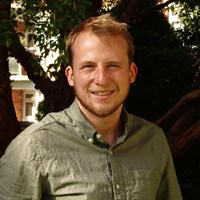People
Dr Josh Cork
Lecturer in Mathematics

School/Department: Computing and Mathematical Sciences, School of
Email: josh.cork@leicester.ac.uk
Web: Personal webpage
Profile
I am a mathematician and mathematical physicist. I completed my Ph.D. between 2014 and 2018 at the University of Leeds. Before coming to Leicester I was a Teaching Associate in Pure Mathematics at Lancaster University and a Postdoctoral Research Assistant in the Institut für Theoretische Physik at Leibniz University Hannover Germany.
I am currently Deputy Director of Admissions, and Outreach Tutor for Mathematics.
I hold fellowship of Advance HE, the national body for teaching in Higher Education in the UK.
Research
My research is mainly focused on gauge theory and topological solitons. Topological solitons are, loosely speaking, stable solutions to classical field equations which owe their stability to global (topological) properties of the fields, for example a winding number. Solitons play a key role in physics as they are candidates for particles in the theory. Important examples (which I am interested in) are instantons in Yang-Mills theory, monopoles in Yang-Mills-Higgs theory, and skyrmions in the Skyrme model (a geometric model of nuclei). Topological solitons have applications in many places: such as condensed matter physics, cosmology, and mathematical biology, and play a key role in the bridge between pure and applied mathematics.
The majority of my research has been devoted to developing and improving tools for constructing exact and approximate examples, and classifying solitons. For example, I have constructed and classified calorons (periodic instantons) with cyclic symmetries, and I have been working (along with my collaborators) on how to extract information about low-energy properties of nuclei in the three-dimensional Skyrme model via instantons and calorons in four-dimensions. More recently I have been applying techniques from differential geometry and topology in order to formalise a geometric framework for studying gauge theoretic properties of skyrmions.
There is a global community who are actively involved in studying topological solitons. Find out more via the lively online solitons at work network.
For further information on my research, please visit my personal homepage.
Publications
J. Cork and L. Disney-Hogg, "Locations of JNR skyrmions"; Math. Phys. Anal. Geom. 28 17 (2025)
J. Cork and C. Halcrow, "Quantization of skyrmions using instantons"; Phys. Rev. D 110, 016027 (2024)
J. Cork and D. Harland, "Finkelstein-Rubinstein constraints from ADHM data and rational maps"; Phys. Lett. B. 850, 138542, 2024
J. Cork and D. Harland, "Geometry of gauged skyrmions"; SIGMA 19 (2023), 071
J. Cork and C. Halcrow, "ADHM skyrmions"; Nonlinearity 35 (2022) 3944
J. Cork, D. Harland, and T. Winyard, "A model for gauged skyrmions with low binding energies"; 2022 J. Phys. A: Math. Theor. 55 015204
J. Cork, EŞ. Kutluk, O. Lechtenfeld, and AD Popov, "A low-energy limit of Yang-Mills theory on de Sitter space"; J. High Energ. Phys. 09 (2021) 89
J. Cork, "Skyrmions from calorons"; J. High Energ. Phys. 11 (2018) 137
J. Cork, "Symmetric calorons and the rotation map"; J. Math. Phys. 59 (2018), no. 6, 062902
Supervision
Current PhD students and projects
Matthew Dales, instantons on ALF spaces
Please contact me if you are interested in working with me on a postgraduate degree. Potential (broad) project topics include: Constructions of instantons; quantisation of skyrmions; geometry of topological solitons.
I also offer 3rd and 4th year undergraduate research projects. Past projects, and projects I currently supervise are listed below.
Current UG projects
2023-24: The mathematics of physics - from classical to quantum mechanics
Past UG projects
2022-23: The geometric topology of knots and links (Year 3)
2022-23: Riemannian geometry: understanding the fabric of spacetime (Year 4)
Teaching
Current (2023/24)
Year-long
MA3516 Mathematics Research Project (coordinator)
Semester 1
MA3144 and MA4144 Topology
MA3152 and MA4152 Curves and SurfacesSemester 2
MA1105 Sets, Relations, and Groups
Previous teaching at Leicester:
MA3153/4153 Number Theory (2023)
MA1027 Plane Geometry (2022,2023)
MA2021 Differential Equations and Dynamics (2022)